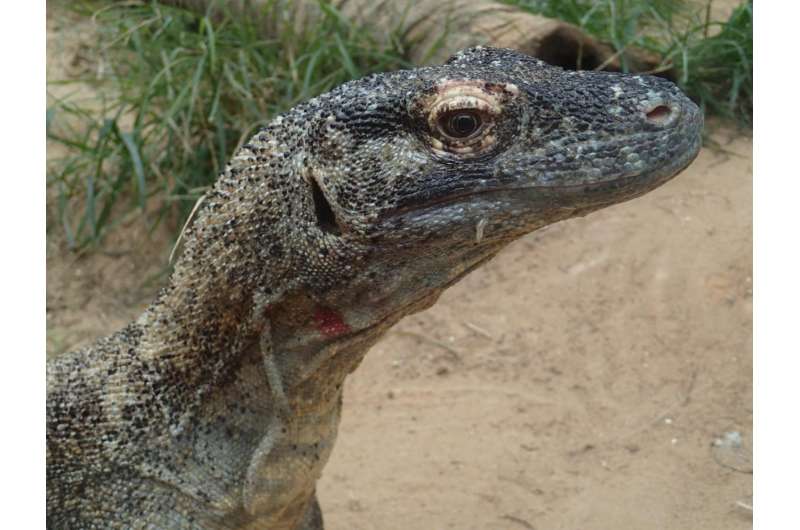Antimicrobial substances identified in Komodo dragon blood

In a land where survival is precarious, Komodo dragons thrive despite being exposed to scads of bacteria that would kill less hardy creatures. Now in a study published in the Journal of Proteome Research, scientists report that they have detected antimicrobial protein fragments in the lizard's blood that appear to help them resist deadly infections. The discovery could lead to the development of new drugs capable of combating bacteria that have become resistant to antibiotics.
The world's largest lizard, Komodo dragons live on five small islands in Indonesia. The saliva of these creatures contains at least 57 species of bacteria, which are believed to contribute to the demise of their prey. Yet, the Komodo dragon appears resistant to these bacteria, and serum from these animals has been shown to have antibacterial activity. Substances known as cationic antimicrobial peptides (CAMPs) are produced by nearly all living creatures and are an essential part of the innate immune system. So, Barney Bishop, Monique van Hoek and colleagues at the College of Science at George Mason University wondered whether they could isolate CAMPs from Komodo dragon blood, as they previously had done with alligator blood to expand the library of known CAMPs for therapeutic studies.
The team used an approach known as bioprospecting. They incubated Komodo dragon blood with negatively charged hydrogel particles that they developed to capture the peptides, which are positively charged. With this method, they identified and sequenced 48 potential CAMPs with mass spectrometry. All but one of these was derived from histone proteins, which are known to have antimicrobial activities. Eight were synthesized and tested against Pseudomonas aeruginosa and Staphylococcus aureus. Seven of the peptides showed significant potency against both bacteria. The eighth was only effective against P. aeruginosa. The researchers conclude that Komodo dragon blood plasma contains a host of potentially viable antimicrobial peptides that could help lead to new therapeutics.
More information: Barney M. Bishop et al. Discovery of Novel Antimicrobial Peptides from Varanus komodoensis (Komodo dragon) by Large Scale Analyses and-Assisted Sequencing using Electron Transfer Dissociation Mass Spectrometry, Journal of Proteome Research (2017). DOI: 10.1021/acs.jproteome.6b00857
Abstract
Komodo dragons are the largest living lizards and are the apex predators in their environs. They endure numerous strains of pathogenic bacteria in their saliva and recover from wounds inflicted by other dragons, reflecting the inherent robustness of their innate immune defense. We have employed a custom bioprospecting approach combining partial de novo peptide sequencing with transcriptome assembly to identify cationic antimicrobial peptides from Komodo dragon plasma. Through these analyses, we identified 48 novel potential cationic antimicrobial peptides. All but one of the identified peptides were derived from histone proteins. The antimicrobial effectiveness of eight of these peptides was evaluated against Pseudomonas aeruginosa (ATCC 9027) and Staphylococcus aureus (ATCC 25923), with seven peptides exhibiting antimicrobial activity against both microbes, and one only showing significant potency against P. aeruginosa. This study demonstrates the power and promise of our bioprospecting approach to cationic antimicrobial peptide (CAMP) discovery and it reveals the presence of a plethora of novel histone-derived antimicrobial peptides in the plasma of the Komodo dragon. These findings may have broader implications regarding the role that intact histones and histone-derived peptides play in defending the host from infection. Data are available via ProteomeXChange with identifier PXD005043.
Journal information: Journal of Proteome Research
Provided by American Chemical Society





















